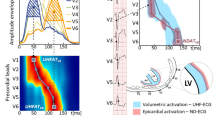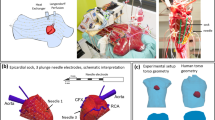Abstract
After corrective surgery for congenital heart defects, scars may create fractionation and delay of the electrical signals in the heart muscle, providing a substrate for arrhythmias. Signalaveraged electrocardiograms (SAECGs) were obtained from 33 children after right ventriculotomy, on average 6 years after surgery, and from 38 healthy controls of the same age. The duration of the filtered QRS complex (fQRS), the duration of the low amplitude signal (<40μV) in the terminal QRS complex (LAS40), and the root mean square amplitude of the terminal 40 ms of the QRS complex (RMS40) were determined. The values of fQRS ≥117 ms, RMS40≤25μV, and LAS40≥35 ms, which were beyond the mean ±2 SD of the healthy controls, were considered abnormal. Most patients had right bundle branch block and therefore a prolonged fQRS. Late potentials were defined as present if both the RMS40 and LAS40 were abnormal. Altogether nine patients (27%) had late potentials. In the patients with late potentials the incidence of serious ventricular arrhythmias was 44% (4 of 9) and in the patients without late potentials 0% (0 of 24). In seven patients with enlargement of the right ventricle, the incidence of arrhythmias was 57% (4 of 7) when late potentials were present and 0% (0 of 7) when they were absent. In the present study late potentials were associated with a history of arrhythmias, especially when the right ventricle was enlarged. Therefore the SAECG may be useful for determining the risk of serious arrhythmia events in children operated for congenital heart defects.
Similar content being viewed by others
References
Al-Joundi B, Chaitman BR (1992) The use of electrocardiography as a diagnostic and prognostic tool in coronary artery disease.Curr Opin Cardiol 7: 587–597
Breithardt G, Cain ME, El-Sherif N, et al. (1991) Standards for analysis of ventricular late potentials using high resolution or signal-averaged electrocardiography: a statement by a task force committee between the European Society of Cardiology, the American Heart Association and the American College of Cardiology.Eur Heart J 12: 473–480
Camm AJ (1992) Programmed electrical stimulation, signal averaged electrocardiogram, and the implantable cardioverter-defibrillator in ventricular arrhythmias.Curr Opin Cardiol 7: 55–64
Chandar JS, Wolff GS, Garson A, et al. (1990) Ventricular arrhythmias in postoperative tetralogy of Fallot.Am J Cardiol 65: 655–661
Deanfield JE, McKenna WJ, Hallidie-Smith KA (1980) Detection of late arrhythmia and conduction disturbance after correction of tetralogy of Fallot.Br Heart J 44: 248–253
Denjoy, Lucet V, Do-NGoc D, Leclercq JF, Coumel P (1992) Signal-averaged ECG in children with apparently idiopathic ventricular arrhythmias.Eur Heart J 13: 328 [abstract]
El-Sherif N, Bekheit S, Turitto G, et al. (1992) Late potentials in postinfarction period: role in risk stratification strategies. In: El-Sherif N, Turitto G (eds)High-Resolution Electrocardiography. Futura, New York, pp 427–446
Fontaine JM, El-Sherif N (1992) Bundle branch block and the signal-averaged electrocardiogram. In: El-Sherif N, Turitto G (eds)High-Resolution Electrocardiography. Futura, New York, pp 533–567
Fuster V, McGoon DC, Kennedy MA (1980) Long-term evaluation (12–22 years) of open heart surgery for tetralogy of Fallot.Am J Cardiol 46: 635–640
Garson A (1984) Ventricular dysrhythmias after congenital heart surgery: a canine model.Pediatr Res 18: 1112–1120
Garson A, Randall DC, Gillette PC, et al. (1985) Prevention of sudden death after repair of tetralogy of Fallot: treatment of ventricular arrhythmias.J Am Coll Cardiol 6: 221–227
Garson A Jr, Nihill MR, McNamara DG, Cooley DA (1979) Status of adult and adolescent after repair of tetralogy of Fallot.Circulation 59: 1232–1240
Hammill SC, Tchou PJ, Kienzle MG, et al. (1992) Establishment of signal-averaged electrocardiographic criteria with Frank XYZ leads and spectral filter used alone and in combination with ejection fraction to predict inducible ventricular tachycardia in coronary artery disease.Am J Cardiol 70: 316–320
Hanseus K, Björkhem G, Lundström NR (1988) Dimension of cardiac chambers and great vessels by cross-sectional echocardiography in infants and children.Pediatr Cardiol 9: 7–15
Harken A, Horowitz L, Josephson M (1980) Surgical correction of recurrent sustained ventricular tachycardia following complete repair of tetralogy of Follot.J Thorac Cardiovasc Surg 80: 779–781
James FW, Kaplan S, Chou TC (1975) Unexpected cardiac arrest in patients after surgical correction of tetralogy of Fallot.Circulation 52: 691–695
Kanovsky MS, Falcone RA, Dresden CA, Josephson ME, Simson MB (1984) Identification of patients with ventricular tachycardia after myocardial infarction: signal averaged electrocardiogram, Holter monitoring, and cardiac catheterization.Circulation 70: 264–270
Kavey REW, Blackman MS, Sondheimer HM (1982) Ventricular dysarrhythmias after repair of tetralogy of Fallot: incidence and severity.Am Heart J 103: 342–350
Kertes PJ, Glaubus M, Murray A, Julian DG, Campbell RWF (1984) Delayed ventricular depolarization—correlation with ventricular activation and relevance to ventricular fibrillation in acute myocardial infarction.Eur Heart J 5: 947–1083
Kobayashi J, Hirose H, Nakano S (1984) Ambulatory electrocardiographic study of the frequency and cause of ventricular arrhythmia after correction of tetralogy of Fallot.Am J Cardiol 54: 1310–1313
Kuchar DL, Thorburn CW, Sammel NL (1987) Prediction of serious arrhythmia events after myocardial infarction: signal-averaged electrocardiogram, Holter monitoring, and radionuclide ventriculography.J Am Coll Cardiol 9: 531–538
Kugler J, Pinsky W, Cheatham J (1983) Sustained ventricular tachycardia after repair of tetralogy of Fallot: new electrophysiologic findings.Am J Cardiol 51: 1137–1143
Park MK, Guntheroth WG (eds) Normal ECG values and deviations from normal. In:How to Read Pediatric ECGs 1987. Year Book, Chicago, pp 37–49
Quattlebaum TG, Varghese PJ, Neill CA, Donaghoo JS (1976) Sudden death among postoperative patients with tetralogy of Fallot: a follow up study of 243 patients for an average of 12 years.Circulation 54: 289–293
Roge CLL, Silverman NH, Hart PA, Ray RM (1978) Cardiac structure growth pattern determined by echocardiography.Circulation 57: 285–290
Scherlag BJ, Chesterfield GG, Berbari EJ, Lazzara R (1985) Peri-infarction block—late potentials: their relationship, significance and diagnostic implications.Am J Cardiol 55: 839–841
Simson MB (1981) Identification of patients with ventricular tachycardia after myocardial infarction from signals in the terminal QRS comoplex.Circulation 64: 235–242
Simson MB, Untereker WJ, Spielman SR, et al. (1983) Relation between late potentials on the body surface and directly recorded fragmented electrocardiograms in patients with ventricular tachycardia.Am J Cardiol 51: 105–112
Stelling JA, Danford DA, Kugler JD,et al. (1990) Late potentials and inducible ventricular tachycardia in surgically repaired congenital heart disease.Circulation 82: 1690–1696
Zimmerman M, Friedli B, Adamec R, Oberhänsli I (1987) Frequency of ventricular late potentials and fractionated right ventricular electrograms after operative repair of tetralogy of Fallot.Am J Cardiol 59: 448–453
Author information
Authors and Affiliations
Rights and permissions
About this article
Cite this article
Rovamo, L., Mäkijärvi, M., Pesonen, E. et al. Later potentials on signal-averaged electrocardiograms in children after right ventriculotomy. Pediatr Cardiol 16, 114–119 (1995). https://doi.org/10.1007/BF00801908
Issue Date:
DOI: https://doi.org/10.1007/BF00801908




